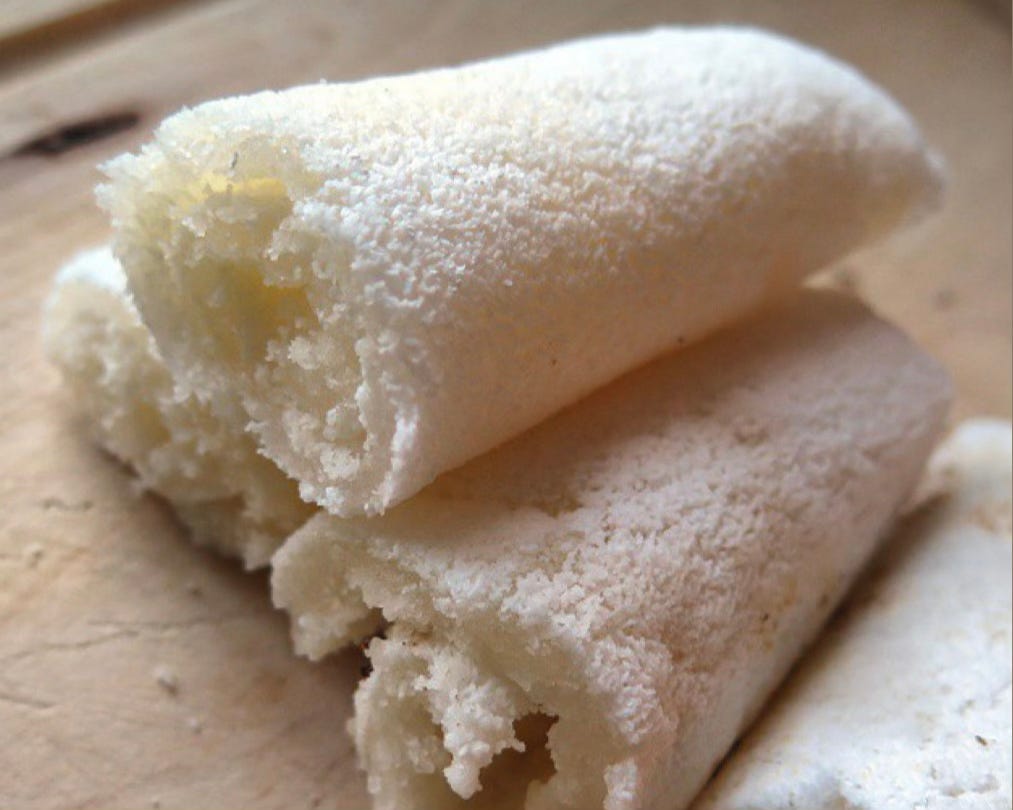Best way to explain “bejú,” “beiju” or “tapioca” would be if I could make one for you the way my grandma and the women from Bahia made them for my mom and the way mom and my aunts made them for me. Now, I make beiju for my kids and loved ones.
It's not just tapioca starch or Polvilho and water, it's our soul food. It is our connection to the land and its abundant gifts. It’s a story passed down through generations, told in dishes like like beiju. We recommit to keeping sharing with each generation. We teach each other from a young age how to prepare and eat “Mandioca” or cassava. That becomes a language we speak with our ancestors.
It took me a while to really feel and understand tapioca starch and how to work with it. Because I don’t live in Brazil, I only get to experience that special handmade tapioca starch when I’m there. Our relatives send “polvilho” from Bahia. I like to think of that flour collecting stories as it travels carried in sacks, cans, on horses, in boxes, cars, buses, passed from hand to hand until it reaches me. That is food that stays alive in me.
Each bag of polvilho feels a little different. I wish I could grow cassava myself, but I can’t where I live now. So it was with great joy that I spent a few hours with my brother, learning how he’s growing cassava on his property. There’s nothing like fresh mandioca, simply boiled with a bit of salt.
"Beiju de tapioca," often shortened to "tapioca," is very popular in Brazil. You can go to specialized restaurants that focus on beiju with savory and sweet options. There are mixes available in the grocery stores, but you still have to cook and eat when it is made. It is a food we enjoy in the moment.
I looked up the origin of the words:
“The name "beiju de tapioca" originates from the Tupi-Guarani languages, spoken by the indigenous peoples of Brazil. In Tupi, "beiju" (also spelled "mbeyú" or "mbeyjú") refers to a type of flatbread or cake made from cassava starch. The term "tapioca" comes from the Tupi word "tïpï'og," meaning "sediment" or "coagulate," describing the process of extracting starch from cassava .”
Luís da Câmara Cascudo, Brazilian anthropologist and folklorist, journalist, who wrote extensively about food and ways of life, listed some types of Beiju:
“Depending on how it’s made or the ingredients used, the “beiju” has a long list of names […]. “Beiju-açu i”s the largest, used to make “caxixi” (a type of rattle); “beiju-caua”, flat and wide like the nests of those bees; “beiju-cica”, sun-dried, brittle, attractive, and sometimes made with cassava starch; “curandá”, with Brazil nuts, pounded; “beiju-membeca”, soft, possibly containing Brazil nut milk—a later refinement, a local variation of northern coconut tapioca; “beiju-peteca”, thick, beaten, dense, with a rough lump, satisfying hunger because it must be chewed slowly; “biju-quira”, with fruit pieces or juice; “beiju-ticanga”, dry, made from fermented cassava (“mandioca-puba”), slightly bitter; “beiju-toteca”, somewhat burnt, used to make a drink; and “beiju-turua”, made from tapioca, thin.”
How to make beiju de tapioca
2 cups of tapioca starch, large pinch of salt
1/2 cup of water ( start slowly you may not need all of it. To test, if you make fist with the flour and when you open your hand it makes a ball that does not fall apart, there is probably enough moisture. If not, add a few sprinkles of water to hydrate).
Sift the starch by passing the hydrated starch through a fine sieve to get an even, sandy texture. This helps it cook evenly and creates a soft but slightly crispy shell.
Heat a non-stick pan (no oil!) over medium heat, add about 1/3 cup of sifted tapioca starch. Spread it evenly in a round shape, about 1/4 inch thick. I use a cast iron pan.
Cook for 1–2 minutes. It will bind and form a crepe on its own.
Once it’s holding together and the edges are a little dry, flip it for another 30 seconds
Add fillings.
Serve hot. It is really best fresh. We eat with lots of salted butter.
We love with cheese, eggs, doce de leche... And of course my favorite with “manteiga de garrafa” , a kind of Brazilian ghee from the Northeast of Brazil. We eat with lots of salted butter.





